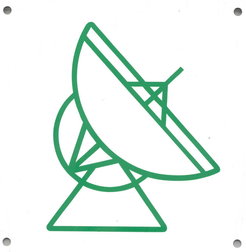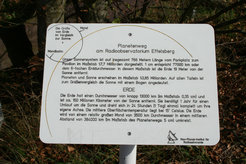Planetary Trail and Radio Telescope Trail
The Effelsberg 100-m radio telescope of the Max-Planck-Institut für Radioastronomie (MPIfR) is located in a creek valley directly crossed by the border line between the states of Northrhine-Westfalia and Rhineland-Palatinate in Germany. It can be reached from a parking lot close to the two villages Lethert and Effelsberg, both parts of the town of Bad Münstereifel. From there it’s a walk of about 15 minutes to the visitors’ pavilion in sight distance to the telescope. Along the connecting road a topical astronomy trail has been assembled, the “Planetary Trail”, scaled 1 : 7.7 billion (1 : 7.7 x 109), covering the distance of 766 meters from the parking lot (panel “Pluto”) to the visitors’ pavilion (panel “Sun”). The Planetary Trail was built in 2004 and leads from dwarf planet Pluto and the outer gas giants in the solar system along the inner rocky planets including the Earth to the sun which is displayed as a concrete ball of about 40 cm diameter in the courtyard of the pavilion.
A virtual expansion of the Planetary Trail leading to one of the stellar neighbours of the sun, the bright star Sirius, has been completed. In the scale of the planetary walk Sirius will be in a distance of 11,000 kilometers – that’s the distance to the Atacama Pathfinder Experiment (APEX) in northern Chile. APEX is a partnership of the MPIfR with the European Southern Observatory and the Swedish Onsala Space Observatory. The virtual station "Sirius" of the Effelsberg Planetary Trail can be found at the back side of the APEX telescope.
The planetary trail is part of a more comprehensive trail that was installed in collaboration with the Tourist-Information/town of Bad Münstereifel and the Bad Münstereifel grouip of the Eifelverein.This “Radio Telescope Trail” leads over a distance of 13 kilometers from the centre of Bad Münstereifel and Rodert youth hostel to the visitors’ pavilion of the Effelsberg radio telescope. The distance from the youth hostel to the telescope is a bit less than 12 kilometers.
Since 2019, this hiking trail has been integrated into the concept of the “Eifelschleifen” (Eifel loops) and forms the Eifelschleife "Zum Radioteleskop" with a total length of 12.9 km from Bad Münstereifel to the Effelsberg radio telescope:
Eifelschleife „Zum Radioteleskop“
The last section of the Eifelschleife “Zum Radioteleskop” contains on a length of almost 800 meters 10 panels of the Planetary Trail, from dwarf planet Pluto to the sun. The radio telescope walk was marked with a green telescope symbol which was also displayed in the hiking map “Bad Münstereifel” (map no. 7 of the Eifelverein).

In the following we present information taken from the panels of the Planetary Trail:
Our solar system is displayed on ten panels at the route from the parking lot to the visitors’ pavilion. The resulting scale for the Planetary Trail is 1 : 7,7 billion. 1 cm corresponds to 77,000 kilometers or six times the diameter of Earth. In this scale Pluto is at a distance of 766 meters from Earth.

Planetary Walk at Effelsberg: Station "Earth".
The diameters of the planets are illustrated with scaled holes in the upper left of each panel. For a better display, the scale of these holes has been enhanced to 1: 3.6 billion. All panels show for comparison an arc with the diameter of the sun in the same scale.
At the General assembly of the International Astronomical Union (IAU) in August 2006 in Prague the term “planet” was defined a bit more accurately. According to the new definition there are eight planets in our Solar system (Mercury, Venus, Earth, Mars, Jupiter, Saturn, Uranus and Neptune), placing Pluto similar to Ceres in the asteroid belt between Mars and Jupiter and also Eris, discovered in 2005, into the newly defined category of “dwarf planets”. In our planetary walk the dwarf planet Pluto is still marking the starting point at the parking lot. In the talks at the visitors’ pavilion the mnemonic for the planets in the solar system has been slightly changed: "My Very Excellent Mother Just Served Us Nachos" (instead of “Nine Pizzas”).
In 2018, the Planetary Trail at the radio telescope near Effelsberg has been considerably expanded:
Astronomy Walks in Effelsberg – how Sirius is coming to Chile
Sirius, the brightest star in the night sky, is one of the nearest neighbours of the sun in a distance of 8.6 light years. In the scale of the Planetary Trail (1 : 7.7 billion) that corresponds to a distance of 11,000 km or almost exactly the distance of two of MPIfR’s radio telescopes: the 100-m radio telescope near Effelsberg and APEX in the Chilean Atacama desert, 5100 m above sea level. Including Sirius, the Planetary Trail at Effelsberg is probably the longest astronomical trail in the world.
In the scale of the Milky Way Trail (1 : 100 quadrillion, or 1 : 1017), however, both stars (Sun and Sirius) are only 90 cm apart: Milky Way Trail.
Page 2: Description of the stages of the Planetary Trail.

